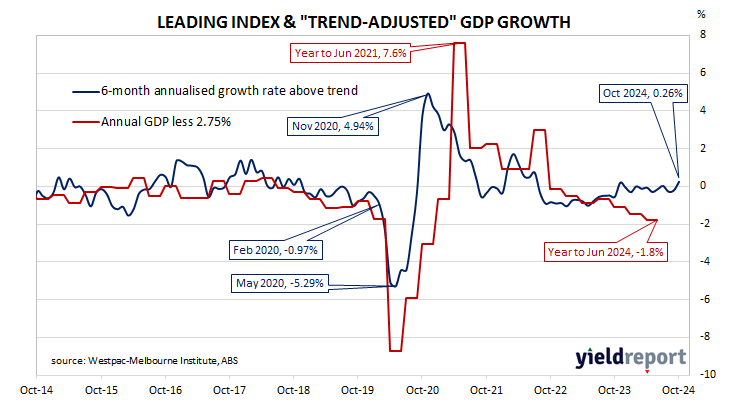Summary: Leading index growth rate rises in October; Westpac: slightly negative for best part of a year; reading implies annual GDP growth of around 2.75%-3.00%; ACGB yields generally decline a little; rate-cut expectations barely move; Westpac: latest reading is best interpreted as pointing to tentative normalisation in growth.
Westpac and the Melbourne Institute describe their Leading Index as a composite measure which attempts to estimate the likely pace of Australian economic growth in the short-term. After reaching a peak in early 2018, the index trended lower through 2018 and 2019 before plunging to recessionary levels in the second quarter of 2020. Subsequent readings spiked towards the end of 2020 but then trended lower through 2021 and 2022 before flattening out in 2023 and 2024.
October’s reading has now been released and the six month annualised growth rate of the indicator registered +0.26%, up from September’s revised figure of -0.20%. The index reading represents a rate relative to “trend” GDP growth, which is generally thought to be around 2.50% to 2.75% per annum in Australia.
“The Leading Index growth rate’s sudden lift into positive territory provides a more constructive signal on the economy’s future momentum,” said Westpac economist Ryan Wells.
Westpac states the index leads GDP growth by “three to nine months into the future” but the highest correlation between the index and actual GDP figures occurs with a three-month lead. The current reading may therefore be considered to be indicative of an annual GDP growth rate of around 2.75% to 3.00% in the next quarter.
Short-term domestic Treasury bond yields finished steady on the day while longer-term yields declined a little. By the close of business, the 3-year ACGB yield had returned to its starting point at 4.08% while 10-year and 20-years both finished 1bp lower at 4.57% and 4.90% respectively.
Expectations regarding rate cuts in the next twelve months barely moved, with a February cut currently viewed as unlikely. Cash futures contracts implied an average of 4.32% in December and 4.295% in February 2025. October 2025 contracts implied 3.885%, 45bps less than the current cash rate.
“The last month has seen the realisation of significant event risk, particularly around the US election,” Ryan added. “The reverberations from these events are still being digested. For that reason, the latest reading is best interpreted as pointing to a tentative normalisation in economic growth from its current subdued pace, given the backdrop of consistent sluggish readings.”
The RBA’s November Statement on Monetary Policy GDP growth forecasts are pretty much in line with Westpac’s latest numbers, which are 1.5% for calendar 2024 and 2.4% for calendar 2025. The RBA forecasts GDP growth for the years ending December 2024 and December 2025 to be 1.5% and 2.3% respectively.


